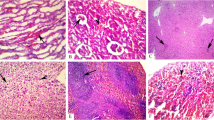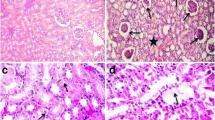Abstract
Female BALBc mice were administered HgCl2 at a single dose of 4 mg/kg i.p. The acute intoxication with Hg(II) salts (2 hr) caused accumulation of Hg(II) ions in the adrenal gland in general, and in the medulla, in particular. Based on data obtained with atomic absorption spectroscopy and quantitative cytochemistry, we determined the amount of mercury (II) in the adrenal glands and found it to be 14.2 ng Hg(II) (3.5 mg/kg wet weight of the adrenals). An uneven distribution of Hg(II) was found within the adrenal gland, not only between the medulla and cortex, but also within the cortex. The applied autometallographic method revealed that the cortex was negative except the zona glomerulosa, whereas the medulla showed a strong reaction localised to the chromaffin granules of the secretory cells. Both adrenaline and noradrenaline producing cells reacted. The comparison of the density of silver grains by scanning densitometry in the medulla and cortex revealed a significantly higher Hg(II) concentration in the medulla compared to the cortex (10 mg/kg vs 2 mg/kg, respectively). The results presented here suggest that there may be a connection between the symptoms of acute Hg(II) intoxication and its adrenal accumulation.
Similar content being viewed by others
References
Brown TA and Smith DG: Cytochemical localization of mercury in Cryptococcus albiclus grown in the presence of mercuric chloride. J Gen Microbiol99:435–441, 1977.
Cheek DB, Bondy RK and Johnson LR: The effect of mercurous chloride (calomel) and epinephrine (sympathetic stimulation) on rats: the importance of the findings to mechanisms in infantile acrodynia(pink disease). Pediatrics 23:302–313. 1959.
Danscher G and Schroder HD: Histochemical demonstration of mercury induced changes in rat neurons. Histochemistry 60:1–7. 1979.
Danscher G, Horsted-Bindsley P andRungby J: Traces of mercury in organs from primates with amalgam fillings. Exp Mol Pathol 52:291–299. 1990.
Henningsson C, Hoffmann S, McGonigle L and Winter JSD: Acute mercury poisoning (acrodynia) mimicking pheochromocytoma in an adolescent. J Pediatr 122:252–253. 1993.
Kevorkian J, Cento DP, Hyland JR.et al: Mercury content of human tissues during the twentieth century. Am J Public-Health 62:504–513. 1972.
Magos L, Brown AW, Sparrow S, et al.: The comparative toxicology of ethyl- and methylmercury. Arch Toxicol 57:260–267.1985.
Nielsen JEandAndersen O: Methyl mercuric chloride toxicokinetics in mice. I. Effeets of strain, sex. route of administration and dose. Pharmacol Toxicol 68:201–207. 1991.
Passow H, Rothstein A and Clarkson TW: The general pharmacology of the heavy metals. Pharmacol Rev 13:185–206. 1961.
Rasmussen BL and Thoracins-Ussing O: Ultrastructural localization of mercury in adrenals from rats exposed to methyl mercury. Virch Arch. B Cell Pathol 52:529–538. 1987.
Seheuhammer AM and Bond D: Factors affecting the determination of total mercury in biological samples by continuousflow cold vapor atomic absorption spectrophotometry. Biol Trace Element Res 31:119–129. 1991.
Shigafoos J, Chestnut WG, Merrill BM, et al.: Novel peptides from adrenomedullary chromaffin vesicles. J Anat 183:253–264. 1993.
Veltman JC and Maines MD: Alterations of heme. cytochrome P-450 and steroid metabolism by mercury in rat adrenal. Arch Biochem Biophys 248:467–478. 1986.
Winkler H: The adrenal chromaffin granule: a model for large dense core vesicles of endocrine and nervous tissue. J Anat 183:237–252. 1993.
Author information
Authors and Affiliations
Rights and permissions
About this article
Cite this article
Kozma, L., Papp, L., Varga, É. et al. Accumulation of Hg(II) Ions in mouse adrenal gland. Pathol. Oncol. Res. 2, 52–55 (1996). https://doi.org/10.1007/BF02893949
Received:
Accepted:
Issue Date:
DOI: https://doi.org/10.1007/BF02893949




